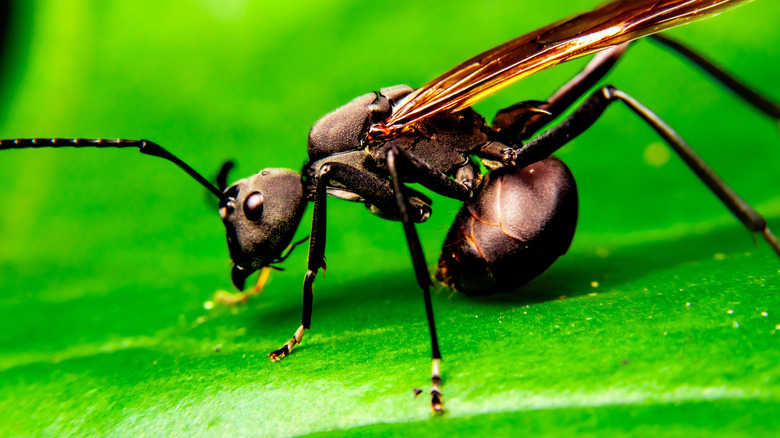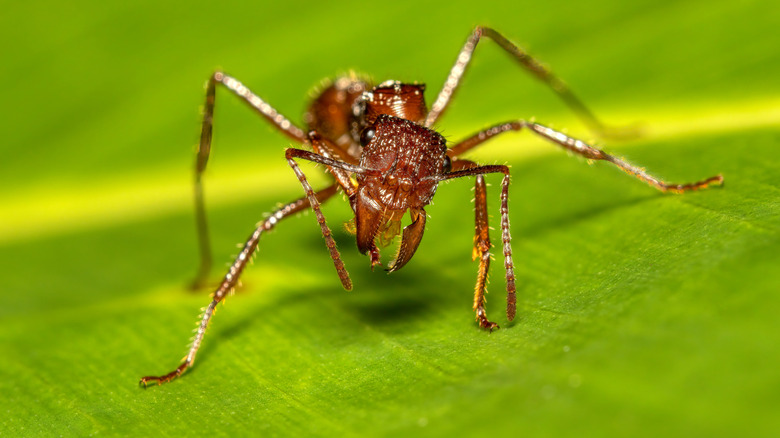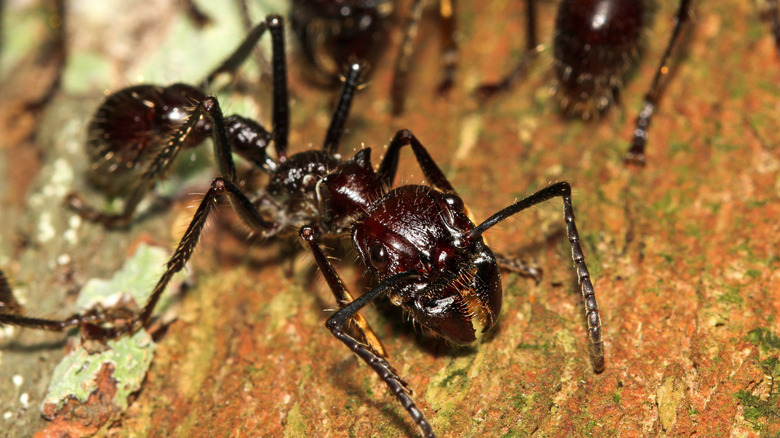The Insect With The Most Agonizing Sting In The World Is Smaller Than You Think
We may receive a commission on purchases made from links.
Some of the smallest animals in the world are deceptively dangerous. The golden poison frog, for example, is the most toxic poisonous frog in the world and in some cases can kill as many as 10 humans with its lethal poison which it secretes from its skin. These tiny toxic menaces typically measure just 1 inch in length which is remarkable when you consider the golden poison frog is frequently cited as one of, if not the most poisonous animal in the world.
Thankfully, the golden poison frog lives only in a tiny area of the Colombian rain forest, but there are plenty of other tiny creatures that can cause incredible pain to humans. We all know that certain insects have a nasty sting, and most of us know what it feels like to be stung by a wasp or bee. Thankfully, many of us will never know what it's like to be stung by a bullet ant, which according to one entomologist has the most painful sting in the world despite the fact the insect measures around an inch in length.
The bullet ant has the most painful sting in the world
The bullet ant lives in the tropical rainforests of Central and South America, and while it might be small in general terms, it's actually one of the largest ant species in existence, measuring between 18 and 30 millimeters (0.7–1.2 inches) in length and weighing no more than 60 milligrams (0.0028 ounces). With six legs and a segmented body, the insect is unmistakably an ant, but it has several notable features that make it look a lot more imposing than your typical black garden ant. Queen bullet ants have wings until they mate, and are slightly larger than the other examples of the species. Otherwise, the bullet ant's scientific name is Paraponera clavata, with "clavata" translating as "club-shaped," in reference to the head shape of the creature.
We already know ants look terrifying under a microscope, but the bullet ant might be one of the best — or worst depending on how you look at it — examples. The species has disproportionately large mandibles which it uses to forage and defend itself, as well as a disproportionately large stinger. As if to warn you of its potent sting, the bullet ant's stinger is actually long in comparison to its body, measuring up to 3.5 mm (0.13 inches). In fairness, "potent" doesn't really cover the extent of this ant's sting, which has frequently been likened to the pain of a gunshot wound — hence the name, bullet ant.
The sting from a bullet ant is known to be the most painful in the world, causing uncontrollable trembling and immediately triggering intense pain which can last for hours and in some cases for a full day.How do we know that the bullet ant has the most painful sting in the world? Well, because one intrepid scientist subjected himself to the experience and reported back that it felt like "pure, intense, brilliant pain."
The man who was willingly stung by a bullet ant
As imposing as the bullet ant looks with its large mandibles and stinger, you might initially think that this small insect couldn't do much damage. But you'd be very wrong. These aren't like the tiny black ants that bite, and we know this thanks to entomologist Justin O. Schmidt. Schmidt created the Schmidt sting pain index, a scale that ranks the pain of insect stings from zero to four. The late entomologist was extremely dedicated to his work, exposing himself to the sting of 150 different species and recording his experiences in various papers before publishing everything together in his 2016 book "The Sting of the Wild."
Ultimately, Schmidt would only give a pain rating of four to three insects, but the first to gain such a rating was the bullet ant. In a 1983 paper entitled "Hemolytic activities of stinging insect venoms," published in Archives of Insect Biochemistry and Physiology, Schmidt described the bullet ant's sting as inducing "immediate, excruciating pain and numbness to pencil-point pressure, as well as trembling in the form of a totally uncontrollable urge to shake the affected part." Later, in "The Sting of the Wild," he described the sting "like walking over flaming charcoal with a three-inch nail embedded in your heel."
What makes the bullet ant venom so potent? Well, the insects produce what's known as a poneratoxin, which is a neuropeptide — a substance that effects neurotransmitters and can increase or decrease the strength of synaptic signaling. In the bullet ant's case, the poneratoxin causes slow muscle contractions and binds to what's called voltage gated sodium channels in neurons. One form of these voltage gated sodium channels is called Nav1.7, which is mainly found on pain receptors. Put simply the poneratoxin affects the Nav1.7 so that its cell sends a continuous message of pain to the brain, which is what gives the bullet ant sting its intense and relentless effect.


